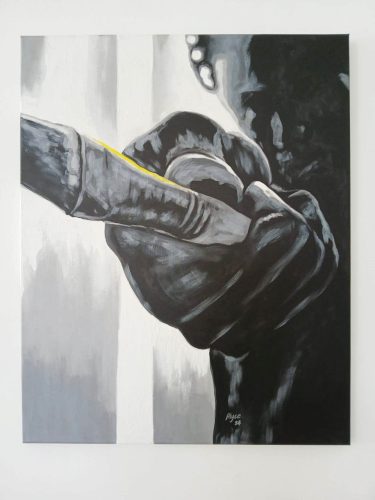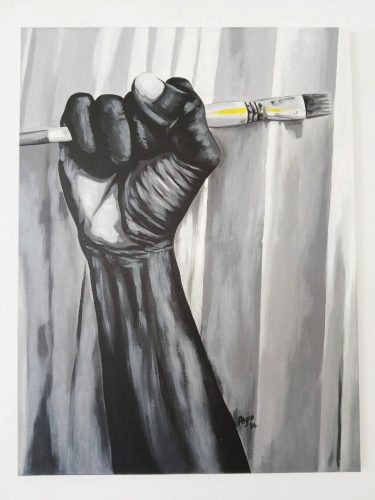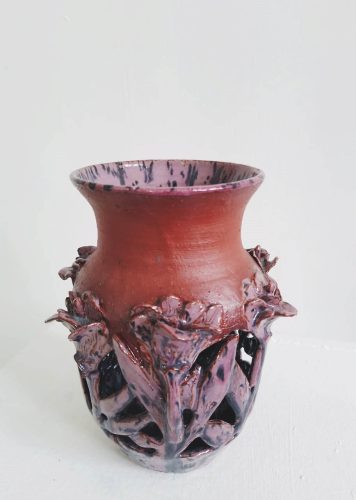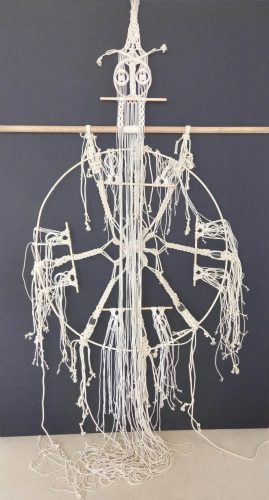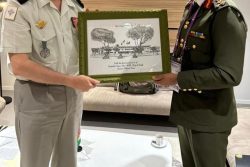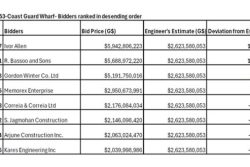On June 14th the E R Burrowes School of Art (BSA) Tutors’ Exhibition closed. The show featured the work of nine of the school’s tutors with artwork ranging from painting and sculpture to collage and interdisciplinary work. I can only compare this exhibition to that of 2022; in 2023 the photos I saw from one of the exhibitors could not tempt me to brave the insanity of the East Coast Highway traffic. This year I was enticed. In fact, I left home specifically to see it.
Last year, I saw in the few photos circulating several large-scale works I had already recently seen, on more than one occasion. This year, the few images I saw in promotion of the exhibition showed fresh work. I was encouraged. And I was pleased when I visited, to not only engage with new work, but also to not be confronted by visual clutter. So, while the 2022 exhibition was cluttered and in need of editing, this year’s exhibition did well in needing neither. Most of the work was given space to breathe and as a consequence allowed to speak and be seen.
The Weapon – Alyce Cameron, Acrylic on Canvas, 2024 (Photo courtesy of the artist)
The Voice – Alyce Cameron, Acrylic on Canvas, 2024 (Photo courtesy of the artist)
Alyce Cameron’s six black and white paintings are part of the series ‘The Creator within the Creator’. Within it, six differently-sized, modestly-scaled canvases each feature a fragment of the human body rendered in high-contrast gray and black. In four of the six paintings, a hand is shown holding a paintbrush. Twice the forearm is visible. In “The Voice” we see the raised forearm which leads the eye to a fisted hand holding a brush. In “The Fight”, the forearm leads the eyes downward to yet another fisted hand firmly holding a brush. The grip on the brush in each of these paintings is not one to evoke thoughts of a steadfast application of paint to a canvas. Instead, the grip suggests on both occasions that the brush is a weapon in a fight that is unfolding. For instance, standing before “The Weapon” we feel ourselves occupying a hostile space. But we are not alone. The paintbrush welding hand is thrust towards our companion on our left. Are we part of the source of aggression? Or are we accidental witnesses to an explosion of anger? Are we silent bystanders? Whatever our role, the owner of the menacing gesture is not the focal point, the fisted hand is. In each of these three paintings, a minuscule hint of yellow is evident on the brush, and in one instance on the hand.
Cameron explains: “I usually use bold colours, and I wanted to move away a bit from that for this particular series. Black and white are strong neutrals that are powerful and dynamic that create depth, dimension, and contrast […].” Cameron’s high-contrast fragments are against a low-contrast grayscale background. While colour is emotionally evocative, black and white paired on the human form easily tones a composition with issues of race. Cameron’s human body fragments rendered in black and grayscale, evoke a body marked by very visible melanin. One, therefore, is justified in thinking that Cameron intends to suggest a mode of response for black bodies deemed hostile and aggressive. Or perhaps it is her own marked body she is giving space to. The accompanying text (artist biographical sketch and artist statement) does not give away to clarity and the ensuing ambiguity causes one to not only localise her potential discourse but to universalise it. Adding to the ambiguity and shifting the reading of the series, the canvases reduce in size from right to left. This reduction of canvas size does not seem coincidental as the largest (“The Creator”) has a partial portrait of the artist and the smallest has a close-up of the previous image in the sequence. This final image is of a brush making a mark, held by an unseen hand. It is titled “The Message”. What is the message? Compounding the ambiguity, the small area of yellow in the sclera of the portrait figure’s right eye (the first painting) is repeated on the brush and/or the hand in subsequent canvases. Is this the creator within the creator?
Without a resolution to these questions, new questions arise. To what extent is the creator of the series asserting non-white maleness as a source of valid artistic creation? Thus, is the human creator of the images engaging with femaleness and blackness/non-whiteness as valid sources of worthwhile art? Should this be the case, Cameron engages with discourses in art that are vibrant beyond our Atlantic shorelines.
Untitled/Floral Ceramic Pot – Dawn Isaacs, 2024 (Photo: Courtesy of the artist)
While clay is relatively easy to source locally, ceramic work is not often done. Very few artists use its media (clay) and techniques as a vehicle for expression. One reason may be, not many visual artists have electric wheels that facilitate wheel throwing for symmetrical construction. And while one may be able to purchase or improvise a tabletop wheel inexpensively to approximate symmetry, the real cause for the limited engagement is that few have access to kilns. With access to a kiln, dried clay work can be fired/heated at very high temperatures further drying out and simultaneously hardening the clay making the work resistant to breakage and crumbling from moisture. As a result of the paucity of accessible kilns, glaze firing is also not possible so ceramic vessels are a rarity in local exhibitions.
Fortunately, these facility challenges are adequately addressed at the BSA so that Dawn Isaacs was able to present a few well-crafted ceramic vessels. Her ceramic work evidences skill in wheel throwing, combining of techniques, and experimentation. In Untitled/Floral Ceramic Pot, Isaacs has wheel-thrown the pot, then used a combination of incising, applique, and carving to build up the floral motifs on its surface. After carefully attending to this stage and once the pot was thoroughly dried, she bisque fired it prior to subjecting it to a second round to fix the glaze.
In other work by Isaacs, she relied on the glazes to enhance the simple wheel-thrown forms. However, in one instance she used leather and cotton threads fixed to the surface to add decorative floral elements to the pot. One wonders how far Isaacs may allow herself to push her ceramic forms so that they are functional and conceptual.
Dream Demon – Robert Cummings, Cotton and wood, 2024 (Photo by A McPherson with permission from the artist)
“She preys from dusk to dawn
Ensnaring dreams you keep
She makes you go to bed in fear
She makes your babies weep
– Excerpt from Dream Demon, by Robert Cummings
Robert Cummings’ macramé sculpture “Dream Demon” is stunning. “Dream Demon” constitutes a new direction in which Cummings has been taking his macramé. “I used to work very tight. [Here] I’ve given myself more freedom and I’m looking more at folk characters, even though in the past I worked with Guyanese themes,” he said. He further explains he used only three knots: the square knot, the double half hitch, and the Josephine knot, which he uses very sparingly. The latter is also the most complex of the three used. As we speak about this work, there is a clear indication of the depth of the work. The poetry of John Agard is mentioned and I realise to understand the genesis of “Dream Demon” I must find Agard’s ‘Quetzy the Saviour’.
While the Tutor’s Exhibition featured work from nine of the school’s tutors I have only featured three whose work distinguished themselves meaningfully for me. Thus, this should not be read as a review or a critique of the show. Cameron’s six paintings were highly conceptual (perhaps too much so). Isaacs’ ceramics were delightful and promising. Meanwhile, Cummings’ work left one eager for the realisation of a body of work exploring echoes of both a national and personal mythic world. My wish now is that Cummings would dedicate himself to producing a body of macramé sculptures to host a solo exhibition and that they will be every bit as beguiling and even more so than “Dream Demon”.
While Burrowes will mark its 50th year next year, I hope that the tutors (most of whom are alumni) will not subsume their exhibition into the special alumni exhibition that is being planned.
(A conversation with Robert Cummings will soon follow.)

